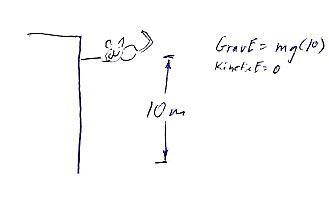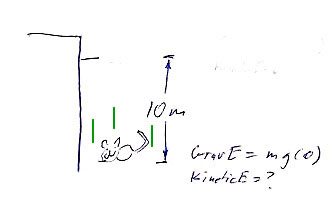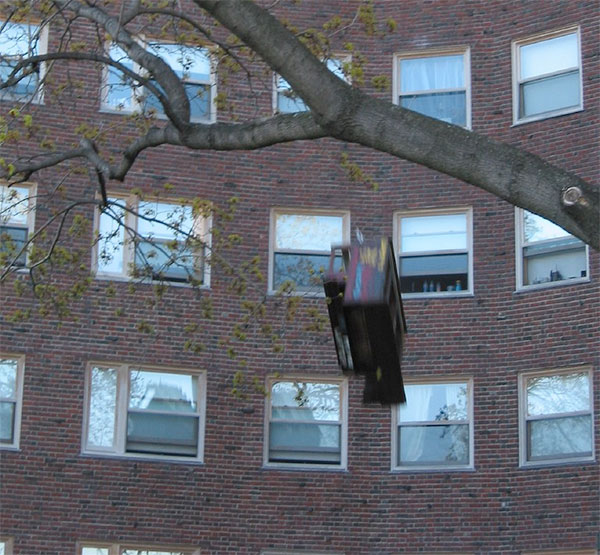Solving problems with KineticE and GravE
We know how much gravitational energy a book on a shelf at a height $h$ above the floor has:$$\text{GravE}=mgh$$
and... We know how much kinetic energy an object moving at a speed $v$ has: $$\text{KE}=\frac 12mv^2.$$
Assuming that we don't have to worry about friction, or any other forces except gravity, there are a number of problems you can do by using the idea of energy conservation for a single object:
$$
\text{GravE lost (or gained)} =
\text{KE gained (or lost)}$$
1.) Joe is on the top floor of the Ad building. He carelessly drops his coffee mug stuffed cat out of the window. It just misses Jill, hits the sidewalk, 10 m below the window. How fast is it moving in meters/second when it hits the sidewalk, 10 m below?
(How fast is this in miles/hr?)
Initial state:

GravE= $mgh_i=m(9.8)(10)=m\cdot 98$
KineticE=$\frac 12 m v_i^2=\frac 12 m (0)^2=0$
Total Energy = $m\cdot 98$
Final state (just before the cat hits the sidewalk):

GravE= $mgh_f=mg(0)=0$
KineticE=$\frac 12 m v_f^2$
Total Energy =$\frac 12 m v_f^2$
So, if total energy is conserved [doesn't change], we have $$ \frac 12 m v_f^2=m\cdot 98 $$ Now, we solve this equation for the speed, $v$. (This is the speed of the stuffed cat just before it hits the sidewalk). We divide both sides of the equation above by $m$, multiply both sides by 2, and then take the square root of both sides to get: $$v=\sqrt{2\cdot 98}=14\text{ m/s = [Google] about 31 miles/hr}$$
2.) Upset, Jill grabs the largest piece cat and throws it back at Joe. If the piece leaves her hand 2 m above the sidewalk, what must its minimum speed be, in order to just make it up to Joe's window?
3.) How much work did Jill do on the mug?
Jill needs to get the mug up to a speed of 14 m/s, so the mug will have a total energy of $\frac 12 m(14)^2$. We need to know the mass of the mug to calculate the energy. We estimated that the mug has a mass of about 1 kg. In which case: $$E=\frac 12 (1)(14)^2=98 \text{ J}.$$
[We know that Work = F*d like we know that amount earned = $7.15/hr * hours...]
3.) According to this video of the SCAD tower drop at Tivoli (Copenhagen), the maximum speed that people reach is 55 mph. How far do they drop?
Roller coasters typically have no engine of their own. They are pulled by a chain or belt up to the highest point on the track, and then let go. Steel wheels on steel rails are very low friction. So....
- Assume that a roller coaster starts from rest ($v_i$=0 m/s) at the highest point
- And that it experiences no friction
- Then all of the GravE that it loses should show up as a gain in KE.
4.) A roller coaster is pulled up to a height of 30 m. How fast is it moving when it has dropped 5 m below the place where it was released? 10 m below the place where it was released?
